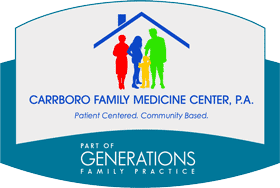Flu vs. Common Cold: How to Tell the Difference
At Carrboro Family Medicine Center, Dr. Yulia Neyman helps patients understand the difference between the flu and the common cold. While both share symptoms like cough and congestion, the flu often appears suddenly with fever, body aches, and fatigue, while a cold tends to develop gradually and is milder. Dr. Neyman provides personalized evaluations to ensure accurate diagnosis and effective care, helping patients recover faster and prevent complications. To consult our professionals, please contact us or book an appointment online. We are conveniently located at 610 Jones Ferry Rd Suite 102, Carrboro, NC 27510.


Table of Contents:
How can I tell if I have the flu or just a cold?
What are the main differences between flu and cold symptoms?
Does a fever always mean it’s the flu?
How quickly do symptoms appear for a cold compared to the flu?
Are body aches more common with the flu or a cold?
Fever and Fatigue: Dr. Yulia Neyman on Key Cold and Flu Differences:
We know that telling the difference between the flu and a common cold can be challenging, since both illnesses often share similar symptoms—such as a runny nose, sore throat, and cough. However, there are some key differences that can help you distinguish between the two and determine whether you need to see your healthcare provider.
The flu, caused by the influenza virus, usually comes on suddenly. People often experience a high fever, chills, body aches, fatigue, and headache. These symptoms tend to be more severe and intense than those of a common cold. It’s also common to have a dry cough, and sometimes nausea or vomiting, especially in children. Many patients report feeling extremely tired and unable to perform daily activities.
In contrast, the common cold typically develops more gradually. Symptoms are usually milder and may include a stuffy or runny nose, sneezing, and a sore throat. You might feel tired or have a mild headache, but high fever and severe body aches are uncommon. Most people with a cold are able to continue their regular routines, although they may feel under the weather.
It’s important to know that both the flu and colds are caused by viruses and cannot be treated with antibiotics. Rest, fluids, and over-the-counter remedies can help manage your symptoms. However, if you or your loved one experiences trouble breathing, chest pain, persistent high fever, or symptoms that worsen instead of improve, it’s best to contact Carrboro Family Medicine Center. Complications can arise with both the flu and colds, particularly for young children, older adults, and those with underlying health conditions.
At Carrboro Family Medicine Center, we often see patients who are unsure whether their symptoms are due to a common cold or the flu. While both are respiratory illnesses, they are caused by different viruses and can present with distinct symptoms.
Flu symptoms tend to appear suddenly and are generally more severe than those of a cold. If you have the flu, you may experience a high fever, chills, body aches, fatigue, and headaches—all of which can come on abruptly. While a sore throat, runny or stuffy nose, and cough can also occur with the flu, these symptoms are usually more pronounced in colds.
Colds, on the other hand, typically develop gradually. The most common cold symptoms include a runny or stuffy nose, sneezing, and a sore throat. Coughs may occur but are milder compared to those seen with the flu. Adults rarely develop a fever or significant body aches with a cold. Although both illnesses can cause tiredness, fatigue is generally much less severe with a cold.
It’s important to note that complications are more common with the flu, especially in young children, older adults, and individuals with weakened immune systems. The flu can sometimes lead to pneumonia or more serious health problems, while colds are usually mild and resolve on their own.
We know that a fever can be worrisome—but it doesn’t always mean you have the flu. While influenza is a common cause of fever, especially during flu season here in Carrboro, many other health conditions can also cause your body temperature to rise.
Fever is the body’s natural response to infection or inflammation and can be triggered by a variety of illnesses. These include viral infections such as the common cold, COVID-19, or other respiratory viruses, as well as bacterial infections like strep throat, urinary tract infections, or pneumonia. Sometimes, fever may even result from non-infectious causes, such as autoimmune diseases, medication reactions, or other medical conditions.
The flu (influenza) often causes a sudden high fever, body aches, fatigue, sore throat, cough, and headache. However, these symptoms can also appear with many other illnesses. That’s why it’s important not to assume that a fever automatically means you have the flu.
At Carrboro Family Medicine Center, we understand how important it is for our patients to recognize the signs and symptoms of common illnesses like the cold and the flu, especially as we approach cold and flu season in the Carrboro community.
One key difference between these two illnesses is how quickly symptoms appear. The common cold tends to develop gradually. You may notice a mild sore throat, runny nose, or sneezing that worsens slowly over a day or two. These symptoms can be uncomfortable, but they usually remain mild to moderate.
In contrast, influenza (the flu) often comes on very suddenly. Many of our patients have described feeling fine in the morning, only to be hit with a high fever, chills, body aches, fatigue, and cough just a few hours later. This abrupt onset and the severity of the symptoms are classic signs of the flu, helping both patients and healthcare providers at Carrboro Family Medicine Center distinguish it from a common cold.
We often see patients concerned about body aches, especially during cold and flu season. Body aches are a common complaint with many viral illnesses, but they tend to be more pronounced and frequent with the flu (influenza) than with the common cold.
The flu is known for causing sudden, intense body and muscle aches that can affect the back, legs, arms, and other parts of the body. These aches are often described as severe and can make it difficult to move around or perform daily activities. In contrast, the common cold may cause mild discomfort or slight aches, but these symptoms are generally much less intense. Colds are more likely to present with symptoms such as a runny or stuffy nose, sneezing, and sore throat, rather than strong body aches.
If you or a family member are experiencing significant body aches along with high fever, chills, fatigue, and weakness, it may be more likely to be the flu rather than a cold. If symptoms are mild and mainly affect the upper respiratory tract, a cold is more probable.
If you are unsure or your symptoms are severe, don’t hesitate to reach out to Carrboro Family Medicine Center. Our providers can perform a thorough evaluation, offer diagnostic testing if needed, and recommend the best treatment to help you feel better as soon as possible. Your health and well-being are our top priorities—schedule an appointment or call us today if you have concerns about flu, cold, or any other symptoms.
At Carrboro Family Medicine Center, Dr. Yulia Neyman teaches patients to use two primary symptoms—fever and fatigue—to distinguish between a cold and the flu. With a common cold, fever is uncommon in adults and usually mild in children, with general tiredness. The flu, conversely, almost always begins with a high fever ($101^{\circ} \text{F}$ or higher) and debilitating fatigue that can last for several days or even weeks. While both involve a runny nose and cough, the presence of these two extreme, sudden symptoms across the body is a reliable sign that a patient needs to be evaluated for influenza, especially since the flu carries a much higher risk of serious complications. To consult our professionals, please contact us or book an appointment online. We are conveniently located at 610 Jones Ferry Rd Suite 102, Carrboro, NC 27510. We serve patients in Chapel Hill NC, Southern Village NC, Fearrington NC, Blands NC, and surrounding areas.
Check Out Our 5 Star Reviews



Additional Services You May Need
▸ Annual Physical Exam
▸ Primary Care
▸ Hypertension Management
▸ Chronic Diseases
▸ Diabetes Management
▸ Immunizations
▸ Lab Testing
▸ Sports Physicals
▸ STD Testing
▸ Allergy Treatment
▸ Acute Illness



